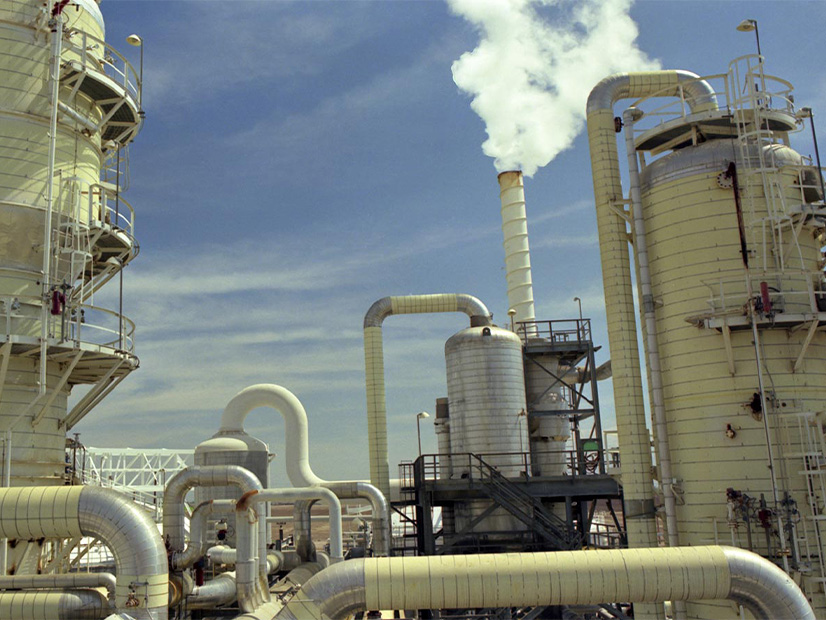
The U.S. Department of Energy wants geothermal energy to provide 60 GW of firm, flexible clean energy to the U.S. grid by 2050, and it’s putting up $84 million from the Infrastructure Investment and Jobs Act (IIJA) to develop a range of nontraditional, “enhanced” geothermal systems (EGS), according to a request for information (RFI) released Tuesday.
Hitting that target would mean a 26-fold increase in the geothermal generation online in the U.S. today, DOE said.
“The U.S. has incredible, untapped geothermal potential beneath our very feet, which can be harnessed to meet our energy demands with a round-the-clock, clean renewable resource available across the country,” Energy Secretary Jennifer Granholm said in Tuesday’s announcement of the RFI. The funds from the IIJA will help “incentivize access to that resource nationwide while helping fossil communities and workers leverage existing infrastructure and skills to seamlessly transition to producing clean energy.”
The IIJA calls for the funds to be used to “demonstrate EGS in different geological settings, using a variety of development techniques and well orientations, at sites where subsurface characterization or geothermal energy integration analysis has been conducted,” the RFI says.
Following those provisions, DOE lays out four specific types of EGS projects it is looking to fund:
- a “proximal” demonstration that is located near an existing geothermal project and uses existing infrastructure (one to four awards, of $5 million to $15 million each);
- a “greenfield” demo on a site “with no existing geothermal development” and the potential for tapping geothermal resources closer to Earth’s surface (one to three awards of $5 million to $25 million each);
- a super-hot, supercritical EGS project drilling potentially several miles into the ground to tap into high-pressure water over 700 degrees Fahrenheit (one to two awards of $5 million to $25 million each); and
- an East Coast EGS project located at a site with existing wells, such as old oil or gas drilling sites (one award of $5 million to $9 million).
All the projects would have immediate or near-term potential to produce electricity or heat. The RFI envisions having an open application process for the funds, with rolling submissions stretching out over two years, and project reviews every six months.
It also asks stakeholders — developers, researchers, tribes, and community and labor groups — to provide feedback on how federal funding can have the greatest impact on covering upfront development costs, building out an inclusive workforce, and benefiting low-income and disadvantaged communities.
Two questions also focus in on supply chain issues, asking what incentives or programs might be needed to “encourage and foster U.S. manufacturing” and what key construction materials — such as iron, steel or other manufactured goods — might not be available domestically.
The RFI also notes that under federal regulations, the applicants for the DOE funding would have to match the amount of the grant, for a 50/50 split. However, DOE is hoping to reset that equation, with the department picking up 80% and awardees providing 20%, in recognition of the cost and complexity of the projects.
The deadline for responding to the RFI is May 13.
500,000 MW
The U.S. is the world leader in geothermal energy, but the country’s 93 geothermal plants located in seven Western states account for only 0.4% of national power generation, according to the Energy Information Administration.
At the same time, as Granholm stressed, geothermal represents a huge potential source of clean, dispatchable power that could balance the U.S. grid as more variable renewable energy projects come online. The U.S. Geological Survey estimates that more than 500,000 MW of EGS resources are available in the Western — about half of the current installed electric power generating capacity in the U.S.
The challenge that the DOE funding hopes to unlock is how to access those resources. While traditional geothermal produces energy by drilling into the ground to tap superheated geothermal brine through existing fractures or permeability in subsurface rock, “enhanced” geothermal uses engineered, manmade systems to tap into reservoirs located below rocks with “limited permeability,” said Lauren Boyd, DOE’s EGS program manager.
Speaking at a March webinar on DOE’s geothermal program plan for 2022-2026, Boyd said EGS requires specialized materials and tools that can be used in “very high temperature, very caustic environments. Commercializing EGS requires the manipulation of the subsurface in these environments; and so, we have the challenge of not only repeatedly controlling and enhancing permeability in general, but just doing that also at super high temperatures and depth, in corrosive environments.”


